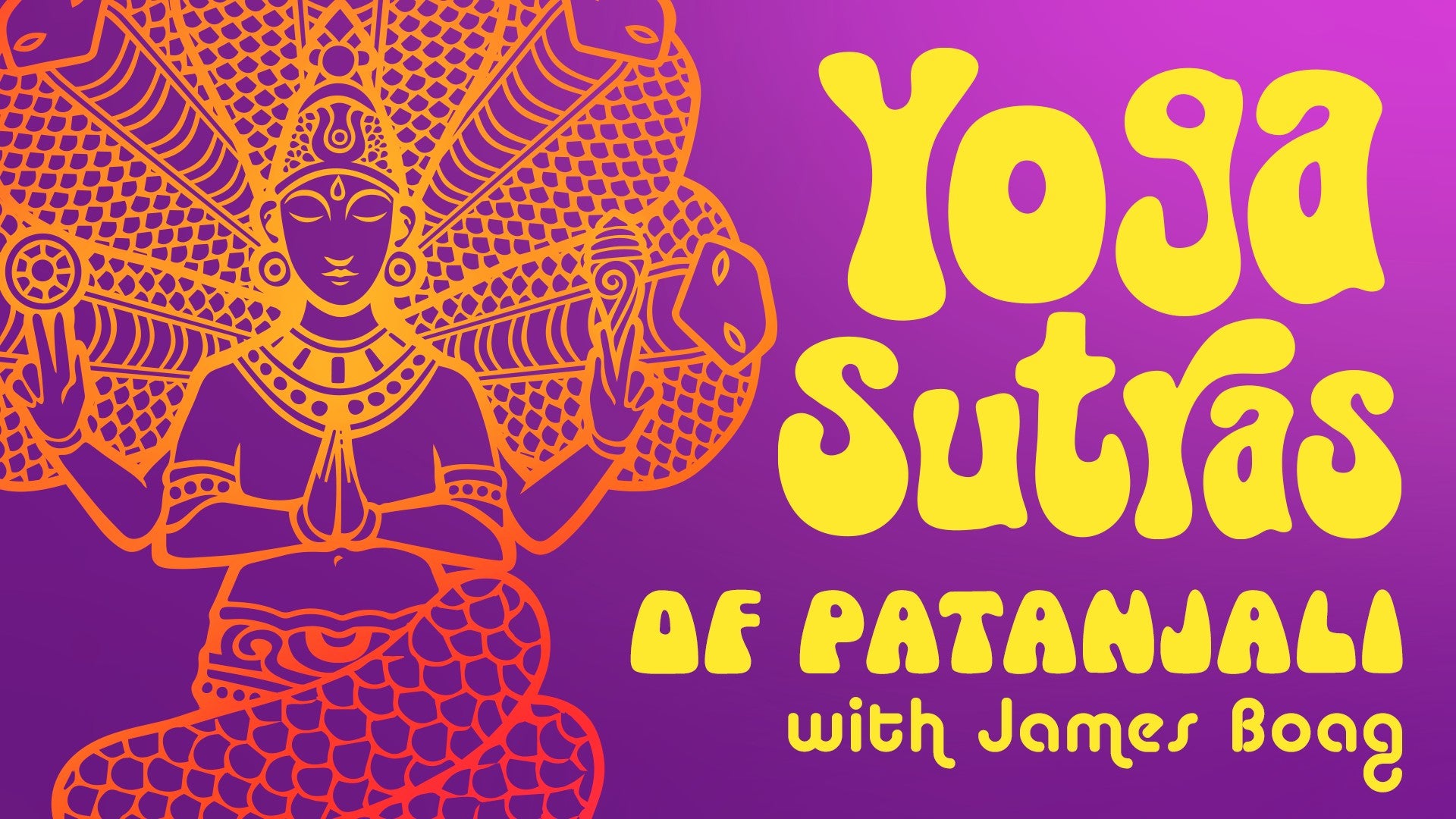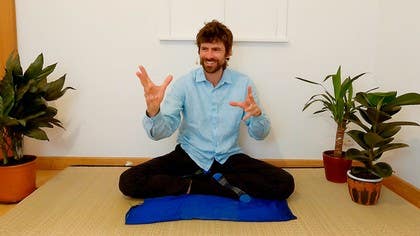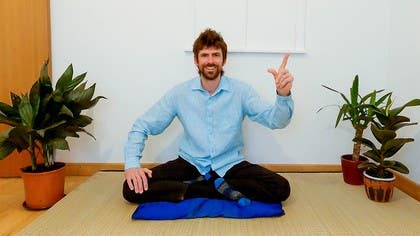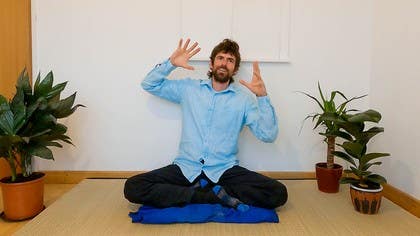Description
About This Video
Transcript
Read Full Transcript
So 34 to 39 these sutras that all contain the particle vÄ쳌. So I'll just quickly recite them so you can hear that vÄ쳌. Pratyardhana vidhÄ쳌rana pyÄ쳌á¹쳌 vÄ쳌 prÄ쳌á¹?asya vÄ«á¹£ayÄ쳌vati vÄ쳌 pratirutpaá¹?a manasastitinibandini vishokÄ쳌v ajyotiá¹£mati vÄ«á¹£arÄ쳌ga vishayamvacittam svaá¹쳌 nidrÄ쳌gnyÄ쳌na rÄ쳌á¹쳌 bhÄ쳌á¹?amvÄ쳌 yatÄ쳌bimatatyÄ쳌nÄ쳌dvÄ쳌. So first, pratyardhana vidhÄ쳌rana pyÄ쳌á¹쳌 vÄ쳌 prÄ쳌á¹?asya. So we hear this word prÄ쳌á¹?a, of the prÄ쳌á¹?a. So what is prÄ쳌á¹?a? The life force. So all of these sutras, they are oceans in and of themselves. What they're all doing is they're encoding so many options of meditative practice in a very, very condensed way. So Patanjali says here, you can meditate on, you can use as a support for subtle meditative practice, all sorts of things to do with prÄ쳌á¹?a, its movements, its retentions.
So this relates, for example, to the movement of the breath in and out of the body. It also relates to the feelings of energy in the body. So all of these things, and look how beautiful this is as well. Maybe you've heard the idea that for certain yoga practices, you need to be initiated into them. You need to be instructed by somebody who is a master of that technique.
But what's the first type of meditative support that Patanjali mentions? The one that we were all initiated into the very moment we emerged into the breathing world when we exed our mother's womb and came into this realm of human embodiment. As long as we're alive, prÄ쳌á¹?a is circulating, at least to some degree, within this organism. We are pulsating, breathing beings. So all of these things to do with pulsation and circulation and the breath, its movements, its retentions, the experiences of energy and life force within us.
We can use these as our support for meditative practice. So what is being laid out here from 34 to 39 are what are referred to by the Sanskrit term alambana. And these are what we could call the supports for yogic meditation. So basically, in yoga meditation, yoga recognizes our chitta, the realm of our awareness. It interacts with external reality through different sense powers, through different action capacities, through our minds, our emotions, our bodies.
And these can operate in lots of different ways and alambana is a support. It's something towards which we can focus our awareness, around which we can gather the powers of our awareness. And so in these sutras, we're getting all these different options and there's literally thousands of them, but they're distilled into these sutras. So this first one, we can meditate on the breath, we can meditate on energy in the body. And just here, there's hundreds of techniques.
And as we continue, we may mention and we may even do some practices together. And on yoga, any time, there's lots of different meditation practices available. Many of them will work with prana in one way or another. Next sutra, vishyavativa pravitrutpaana manasastinibandini. Or we can meditate on subtle sense experience.
And when we do that, it has the effect of bringing greater steadiness to the realm of our awareness and our mind. So this, again, there's a whole ocean here. So mantra, yantra, so working with subtle internal sound, working with internal visualization. All of these possibilities are encoded here. Let's say, for example, I'm working with a subtle internal sound.
What does that necessitate? It requires that I turn the sense power of hearing inwards. Sound vibrates, it requires that I turn my sense power of touch inwards. It's quite possible that when I meditate on an internal sound, I may also use a particular space or place within the body to tune in to. So my internal subtle sight turns inwards.
As I tune into that subtle internal sound, it's almost like I'm also trying to taste, trying to savor the quality of that subtle internal object, whether it's a sound or a visualization. And so the very process of meditating on a mantra internally or an internal visualization, it has this effect of training my mental capacities in the ways of more subtle integrated focus. And so not only do those types of techniques help me tune in to that center point and invite samadhi, but one of the effects of them is they can help the mind come to greater steadiness. So in our modern world, for example, we are often subject to so many disturbing influences. We're being bombarded with all sorts of frequencies and all sorts of information, misinformation, disinformation, propaganda and all this type of stuff.
And the world can sometimes, depending where you live, of course, but it can sometimes be a noisy place. And all of this, of course, it leaves impressions in our mind and it can make our mind even less stable than it might ordinarily be. Even less stable than a mind that in and of itself has a tendency to keep jumping and flitting all over the place because it's doing its job. It's looking for that field of utmost charm. However, if I invite the powers of my awareness to tune in to a subtle internal focus, then this can train those great powers of my awareness to actually come together and support each other so we can then navigate this sometimes busy, sometimes noisy, sometimes confusing and disturbing world more steadily.
So at the same time as potentially as encoding the whole vast ocean of all of those subtle internal techniques, working with sound and visualization and internal sensory experience, he also emphasizes how that can help fortify the steadiness of our awareness. Literally, this means we can use as our support for meditation the effulgent realm that is sorrowless. So we can meditate on the light that is beyond light and dark. We can meditate on light in lots of different ways. Again, there's loads of ways one can do that.
The light of awareness, we can use that as our support in lots and lots of different ways. Lots of different techniques work with light. Very simple one, trataka, working with the flame. And then, again, oceans of subtle internal practice. Maybe working with the light of the sun, but you get the idea.
So many different ways we can work with that. Or we can meditate on desirelessness. Now, you might think, wait a minute, how can I meditate on desirelessness? If I want to say on desirelessness that I'm desiring desirelessness, and how am I going to meditate on desirelessness? The way this is usually interpreted is that we can meditate on a being who has realized that state of desirelessness.
A true realized master, such as Patanjali, such as Bhagavan Krishna, or Jesus Christ, or Lord Buddha. Somebody who actually embodied that desireless state, who was able to really be in that state of yoga. We can use them as the person towards which we orient the powers of our awareness. We can meditate on the guru, as it were. Or we can meditate on an object, an object, a support, from sleep or dream.
What does this mean? So the way, again, this is canonically understood, according to traditional commentaries, is that it may happen that one has a very strong connection with a guru who may or may not still be walking this earthly plane in embodied human form. It could happen that you are there dreaming, you're asleep, and you have a dream, and the guru, oh God, comes to you and instructs you, initiates you in a practice. You can work with that. So it's not that you have some dream when you think, oh, no, it's not just any old dream.
There you are in the dream, and the supreme being or the guru, like the guru we talked about in the previous sutra, like Jesus, like the Buddha, like a realized saint, and there's plenty of them in the Indian tradition, but all over the world there are these realized beings. If somebody like that comes and gives you the teaching in dream, then you can work with that. Or, finally, potentially says, you can meditate on whatever suits you. Again, let us be slightly cautious. This does not mean we can meditate on whatever takes our fancy.
So, for example, if I like ice cream, then ice cream would be a great thing to meditate on. No. We can meditate on whatever is effective in actually bringing samadhi into our experience. Here we see the beautiful inclusivity of Patanjali. And we also see, this reminds me of, maybe you've heard of this teacher called Clarissa Pincola Estes.
She wrote a wonderful book called Women Who Run With the Wolves, and she has a lot of published audio material as well. But one thing she says, I heard it from her, she says, wisdom is what works. Patanjali is always very pragmatic. What works for you? What technique cultivates samadhi for you?
You can work with that. When we start to look into the yoga tradition, we can see there are so many different ways of meditating. And there are certain types of practices, which for some people they think, oh no, that would not work for me at all. So, for example, one time I went to a monastery when I lived in Thailand, it was actually a Buddhist monastery, and the monk who met me took me into a room full of decaying humans, like bones and bits of flesh, and he said, yeah, see you in an hour. And just left me in the room with the human remains.
Also on the grounds of the monastery was a cave. And in this cave, it was a super, super dark cave. Like no light penetrated in there. You know, he takes me in and then blows out the camel, see you in an hour. So a kind of sensory deprivation cave, you might say.
And then in the same monastery, he then took me walking, and the monastery was on an island, and it was on a cliff. And there was this balance beam between two cliffs. He says, yeah, on the new moon night, or the black moon night just before the new moon, when it's not the darkest moon of the month, we come walking barefoot around the monastery grounds, and that's one of our meditations. Now, obviously, that might not be a very effective way of meditating for everybody. But, you know, one person, like there's a Serbian saying, the blacksmith's diet is poison for the cobbler, and the cobbler's diet is poison for the blacksmith.
The physical demands of their job are so different that they require a very different metabolic support from their diet. Same with meditation. But those people who meditate on human remains, who hang out at the cemetery, those people who dress themselves in virgin white cloth, and they sit in a pristine environment, they seem very, very different things. What is perfectly effective for one person might not be much help at all for somebody else. Remember, it's always about balance.
What brings me into balance? And it's really, sooner or later, it's like that's going to be something different from what my friend needs or what my neighbour needs. So as we keep practicing, we start to make the practice more and more our own. But what we see here is potentially this beautiful inclusivity, the inclusivity of the yoga method. Do what works for you.
But when choosing a technique, when working with technique, ensure that it's actually cultivating yoga. It's actually cultivating balance. It's not just making you better at the technique. It's bringing greater equanimity, greater equipoise, greater clarity into the rest of your day.
Yoga Sutras of Patanjali: Whistle Stop Tour of Chapter One
Comments
You need to be a subscriber to post a comment.
Please Log In or Create an Account to start your free trial.










